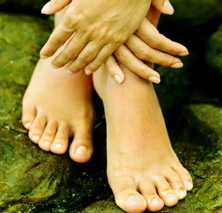Are Those Really Corns on Your Feet?
By
Jane Rivero

There are several conditions that affect the feet that are very
similar. You may think you have foot corns, for example, but in fact you
may have foot calluses. So how do you know for sure? Well, while they
may be similar from some points of view, they all have their specific
traits that differentiates them from one another.
But first of
all, let's see what corns on feet are and how they manifest. Foot corns
are usually thickened areas of skin which are caused by applying too
much pressure on the foot. Shoes usually apply pressure on the top of
the foot, thus the toes are more likely to develop foot corns, as well
as the under the ball of the foot or between the toes. They cause much
discomfort and are painful and unsightly.
Compared to foot
calluses, corns are quite different. Corns on feet are spherically
shaped calluses of dead skin. Foot calluses are also areas where the
skin has become toughened and thick and hard. Calluses tend to be
flatter, thicker and far more extensive. They may cover the whole of the
ball of the foot. In fact, you may have a callus, and have a corn on
top of it!
Callused skin on the feet comes as a result of repeated
friction, pressure or other irritations. The most frequent cause for
their appearance is poor foot mechanics or badly fitting shoes. While
corns on feet usually appear on the upper side of the foot, calluses
develop on the sole of the foot, especially where the first metatarsal
bone joins the big toe, but also on the heel. They are generally not
harmful and don't hurt as much as foot corns, but they can be more
dangerous; as skin ulceration and infections may appear.
Corns
appear as a thickening of the skin on the toes. This thickening appears
as a cone-shaped mass pointing down into the skin. A corn can occur over
a callus or be surrounded by calluses. It has been observed that a corn
is a thicker and more focal area, while foot calluses are more diffuse
thickenings of the skin.
A common cause that leads to the
formation of corns and calluses are hammertoes. A hammertoe is a
condition resulting from keeping the toes tight and bunched up for a
long period of time. Most frequently, they result from wearing
inappropriate footwear or from foot abnormalities. Tight shoes force the
toes to bend and keep them in that bent position for a long period of
time. This causes toe muscles to shorten, which results in the toe
having the appearance of a hammer. Thus the name "hammertoes". Because
the toes are bent upward, they are prone to developing foot corns and
calluses.
Both corns on feet and foot calluses are normal and
natural ways in which the body protects itself. Both calluses and corns
may go away by themselves eventually, but if you want to get rid of them
more quickly, there are some treatment options worthy to be taken into
consideration. These include using a callus shaver, salicylic acid
treatments, alcohol free Goldenseal extract, medicated pads among
others. Remember that tight-fitting shoes though are best avoided.
Jane Rivero writes on foot health and personal wellness. She recommends getting corns on feet checked by a podiatrist, as if the root cause is not found they will return time and time again. If you want to find out why you get foot corns and what you can do to stop them, a trip to the podiatrist is the best bet.
Article Source:
http://EzineArticles.com/?expert=Jane_Rivero












0 comments:
Post a Comment